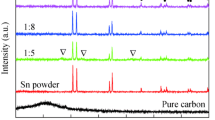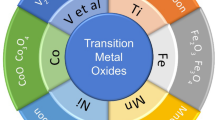Abstract
In this paper, oxidation doping modification of tin-graphite composite anode material, discussing the effect of doping different oxidants on the properties of composites. The structure and morphology were measured by X-ray diffraction (XRD) and scanning electron microscopy (SEM). The electrochemical properties of the samples were investigated by electrochemical impedance spectroscopy (EIS), cyclic voltammetry (CV), and galvanostatic charge and discharge tests. The results showed that the oxidation effect of H2SO4 was better than HNO3 and H2O2. When the tin-graphite composite was oxidized by H2SO4, the material had better electrochemical properties, of which initial specific discharge capacity reached 859 mAh·g−1 at the rate of 0.1C, increasing by 113 and 76 mAh·g−1 compared with the HNO3 and H2O2. The initial discharge specific capacities at rates of 0.2, 0.5, and 1C were 809, 761, and 627 mAh·g−1.










Similar content being viewed by others
References
Burnham A, Han J, Clark CE, Wang M, Dunn JB, Palou-Rivera I (2012) Life-cycle greenhouse gas emissions of shale gas, natural gas, coal, and petroleum. Environ Sci Technol 46(2):619–627
Doyle MW, Havlick DG (2009) Infrastructure and the environment. Social Science Electronic Publishing 34(1):349–373
Lund H (2007) Renewable energy strategies for sustainable development. Energy 32(6):912–919
Han YS, Lee JY (2003) Improvement on the electrochemical characteristics of graphite anodes by coating of the pyrolytic carbon using tumbling chemical vapor deposition. Electrochim Acta 48(8):1073–1079
Julien C (2000) 4-Volt cathode materials for rechargeable lithium batteries wet-chemistry synthesis, structure and electrochemistry. Ionics 6(1–2):30–46
Liu H, Tang D (2009) The effect of nanolayer AlF3 coating on LiMn2O4 cycle life in high temperature for lithium secondary batteries. Russ J Electrochem 45(7):762–764
Goodenough JB, Manthiram A, Wnetrzewski B (2015) Electrodes for lithium batteries. J Power Sources 43(s1–3):269–275
Katz H, Bögel W, Büchel JP (1998) Industrial awareness of lithium batteries in the world, during the past two years. J Power Sources 72(1):43–50
Park YS, Lee TW, Shin MS, Lim SH, Lee SM (2016) Modification for improving the electrochemical performance of spherically-shaped natural graphite as anode material for lithium-ion batteries. J Electrochem Soc 163:3078–3086
Striebel KA, Shim J, Cairns EJ, Kostecki R, Lee YJ, Reimer J, Richardson TJ, Ross PN, Song X, Zhuang GV (2004) Diagnostic analysis of electrodes from high-power lithium-ion cells cycled under different conditions. J Electrochem Soc 151(6):A857–A866
Ma C, Zhao Y, Li J, Song Y, Shi J, Guo Q, Liu L (2013) Synthesis and electrochemical properties of artificial graphite as an anode for high-performance lithium-ion batteries. Carbon 64(Complete):553–556
Casimir A, Zhang H, Ogoke O, Amine JC, Lu J, Wu G (2016) Silicon-based anodes for lithium-ion batteries: effectiveness of materials synthesis and electrode preparation. Nano Energy 27:359–376
Lou S, Cheng X, Zhao Y, Lushington A, Gao J, Li Q, Zuo P, Wang B, Gao Y, Ma Y, du C, Yin G, Sun X (2017) Superior performance of ordered macroporous TiNb2O7, anodes for lithium ion batteries: understanding from the structural and pseudocapacitive insights on achieving high rate capability. Nano Energy 34:15–25
Walter M, Erni R, Kovalenko MV (2015) Inexpensive antimony nanocrystals and their composites with red phosphorus as high-performance anode materials for Na-ion batteries. Sci Rep 5:8418
Dunn JB, James C, Gaines L, Gallagher K, Dai Q, Kelly JC (2015) Material and energy flows in the production of cathode and anode materials for lithium ion batteries. Acta Chem Scand 49:44–52
Zhang WM, Hu JS, Guo YG et al (2010) Tin-nanoparticles encapsulated in elastic hollow carbon spheres for high-performance anode material in lithium-ion batteries. Adv Mater 20(6):1160–1165
Lou XW, Wang Y, Yuan C, Lee JY, Archer LA (2006) Template-free synthesis of SnO2 hollow nanostructures with high lithium storage capacity. Adv Mater 18(17):2325–2329
Yao J, Shen X, Wang B et al (2009) In situ chemical synthesis of SnO2–graphene nanocomposite as anode materials for lithium-ion batteries. Electrochem Commun 11(10):1849–1852
Liu Y, Zhang X (2009) Effect of calcination temperature on the morphology and electrochemical properties of Co3O4 for lithium-ion battery. Electrochim Acta 54(17):4180–4185
Paek SM, Yoo EJ, Honma I (2009) Enhanced cyclic performance and lithium storage capacity of SnO2/graphene nanoporous electrodes with three-dimensionally delaminated flexible structure. Nano Lett 9(1):72–75
Chan CK, Peng H, Liu G, McIlwrath K, Zhang XF, Huggins RA, Cui Y (2008) High-performance lithium battery anodes using silicon nanowires. Nat Nanotechnol 3(1):31–35
Chou SL, Wang JZ, Choucair M et al (2010) Enhanced reversible lithium storage in a nanosize silicon/graphene composite. Electrochem Commun 12(2):303–306
Wang G, Wang B, Wang X, Park J, Dou S, Ahn H, Kim K (2009) Sn/graphene nanocomposite with 3D architecture for enhanced reversible lithium storage in lithium ion batteries. J Mater Chem 19(44):8378–8384
Beaulieu LY, Hewitt KC, Turner RL, Bonakdarpour A, Abdo AA, Christensen L, Eberman KW, Krause LJ, Dahn JR (2003) The electrochemical reaction of Li with amorphous Si-Sn alloys. J Electrochem Soc 150(2):A149
Wang H, Yoshio M (2006) Graphite, a suitable positive electrode material for high-energy electrochemical capacitors. Electrochem Commun 8(9):1481–1486
Tarascon JM, Armand M (2001) Issues and challenges facing rechargeable lithium batteries. Nature 414(6861):359–367
Trifonova A, Stankulov T, Winter M (2008) Study of metal-supported carbon matrix as a high-capacity anode for Li-ion battery. Ionics 14(5):421–425
Wang GX, Yao J, Ahn JH et al (2004) Electrochemical properties of nanosize Sn-coated graphite anodes in lithium-ion cells. J Appl Electrochem 34(2):187–190
He ZK, Sun Q, Xie K, Lu P, Shi ZN et al (2019) Reactive molten salt synthesis of natural graphite flakes decorated with SnO2 nanorods as high performance, low cost anode material for lithium ion batteries. J Alloys Compd 792(2):1213–1222
Author information
Authors and Affiliations
Corresponding author
Additional information
Publisher’s note
Springer Nature remains neutral with regard to jurisdictional claims in published maps and institutional affiliations.
Rights and permissions
About this article
Cite this article
Dai, Y., Li, X., Yu, L. et al. Effect of different oxidants on properties of tin-graphite composite anode material for lithium-ion battery. Ionics 26, 601–606 (2020). https://doi.org/10.1007/s11581-019-03227-7
Received:
Revised:
Accepted:
Published:
Issue Date:
DOI: https://doi.org/10.1007/s11581-019-03227-7




